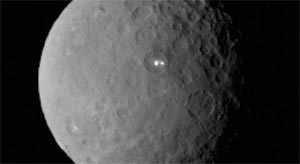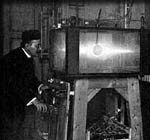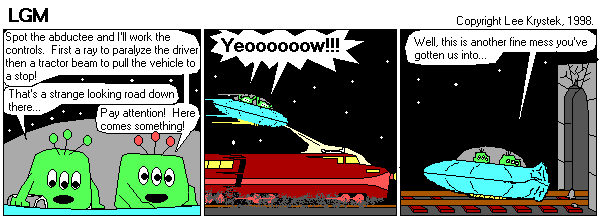|
|
|
|

The
Ceres bright spot as seen by NASA's Dawn spacecraft.
|
Science
Over the Edge
A
Roundup of Strange Science for the Month
June
2015
|
|
In the
News:
 Ceres
Spots Still Mystery - Scientists have been puzzling
awhile about what the bright spots on the dwarf planet Ceres'
surface are. New high resolution photographs taken by NASA's
Dawn spacecraft haven't solved the mystery, but that do
indicate that the spots are actually composed of many smaller
splotches. They don't appear to be "massive doors that open
to allow ships in and out" which some people have suggested.
More likely that may be ice, but there is no way to tell
for sure at this point. On Dawn's next pass in June, which
will be three times closer than this one, we may get some
more photos and possibly some answers. Ceres
Spots Still Mystery - Scientists have been puzzling
awhile about what the bright spots on the dwarf planet Ceres'
surface are. New high resolution photographs taken by NASA's
Dawn spacecraft haven't solved the mystery, but that do
indicate that the spots are actually composed of many smaller
splotches. They don't appear to be "massive doors that open
to allow ships in and out" which some people have suggested.
More likely that may be ice, but there is no way to tell
for sure at this point. On Dawn's next pass in June, which
will be three times closer than this one, we may get some
more photos and possibly some answers.
 Warm
Blooded Fish Found - You may have learned in school
that all fish are cold-blooded, but that is not apparently
true. Nicholas Wegner, a researcher at the National Oceanic
and Atmospheric Administration, examined a deep sea predatory
fish named the Opah (also known as the moonfish) and found
that it warms its blood by rigorously flapping its fins.
This warm bloodedness allows it to be a much more energetic
hunter than other fish that live in deep waters. The opah
can maintain a temperature that is about 41 degrees Fahrenheit
higher than the water around them despite living at a depth
of 1,000 feet. The study was published in the journal Science. Warm
Blooded Fish Found - You may have learned in school
that all fish are cold-blooded, but that is not apparently
true. Nicholas Wegner, a researcher at the National Oceanic
and Atmospheric Administration, examined a deep sea predatory
fish named the Opah (also known as the moonfish) and found
that it warms its blood by rigorously flapping its fins.
This warm bloodedness allows it to be a much more energetic
hunter than other fish that live in deep waters. The opah
can maintain a temperature that is about 41 degrees Fahrenheit
higher than the water around them despite living at a depth
of 1,000 feet. The study was published in the journal Science.
 Ancient
Jerusalem Aqueduct Served for Two Millennia - Construction
workers stumbled across a 2,000-year-old water-supply system
that still worked until the last century. The Lower Aqueduct,
which was built under the direction of kings ruling Jerusalem
from 140 BC to 37 BC, operated by carrying water from a
spring south of Bethlehem into four modern-day Jerusalem
neighborhoods until replaced by an electrical water distribution
system about 100 years ago. The channel was an open sluice
until covered with terra cotta pipe about 500 years ago.
The Israel Antiquities Authority plan to cover part of the
channel "for the sake of future generations" and expose
other parts for the general public to see. "The aqueduct
begins at the 'En 'Eitam spring, near Solomon's Pools south
of Bethlehem," says IAA Director Ya'akov Billig. "Despite
its length, it flows along a very gentle downward slope
whereby the water level falls just one meter per kilometer
of distance." Ancient
Jerusalem Aqueduct Served for Two Millennia - Construction
workers stumbled across a 2,000-year-old water-supply system
that still worked until the last century. The Lower Aqueduct,
which was built under the direction of kings ruling Jerusalem
from 140 BC to 37 BC, operated by carrying water from a
spring south of Bethlehem into four modern-day Jerusalem
neighborhoods until replaced by an electrical water distribution
system about 100 years ago. The channel was an open sluice
until covered with terra cotta pipe about 500 years ago.
The Israel Antiquities Authority plan to cover part of the
channel "for the sake of future generations" and expose
other parts for the general public to see. "The aqueduct
begins at the 'En 'Eitam spring, near Solomon's Pools south
of Bethlehem," says IAA Director Ya'akov Billig. "Despite
its length, it flows along a very gentle downward slope
whereby the water level falls just one meter per kilometer
of distance."
 Four
Close Quasars Surprise Scientists - Astronomers are
surprised to have found a quartet of quasars close together
in a cloud of dense hydrogen gas. Quasars are believed to
be supermassive black holes at the center of galaxies that
for a short period are sucking in huge amounts of matter
and radiating tremendous quantities of energy. They are
thought to be a relatively rare phenomenon. If so, scientists
are wondering, why are four of them so closely group together?
(All within 650,000 light years of each other). It may be
that something about the environment in that part of the
universe, perhaps the hydrogen cloud, promotes quasar creation.
The odds that they are close just by coincidence is one
in 10 million the researchers estimate. "It may be that
quasar episodes are more likely to be triggered in such
an unusual environment, which is rich in both gas and galaxies"
observed Joseph Hennawi with the Max Planck Institute for
Astronomy who led the study. "Current models of how structure
forms in the universe would never predict that there would
be so much cool, dense gas around. Instead, those models
predict that the gas in such a massive object should be
1,000 times hotter and 1,000 times less dense," he added.
This information may give astronomers better insight into
how quasars come about. Four
Close Quasars Surprise Scientists - Astronomers are
surprised to have found a quartet of quasars close together
in a cloud of dense hydrogen gas. Quasars are believed to
be supermassive black holes at the center of galaxies that
for a short period are sucking in huge amounts of matter
and radiating tremendous quantities of energy. They are
thought to be a relatively rare phenomenon. If so, scientists
are wondering, why are four of them so closely group together?
(All within 650,000 light years of each other). It may be
that something about the environment in that part of the
universe, perhaps the hydrogen cloud, promotes quasar creation.
The odds that they are close just by coincidence is one
in 10 million the researchers estimate. "It may be that
quasar episodes are more likely to be triggered in such
an unusual environment, which is rich in both gas and galaxies"
observed Joseph Hennawi with the Max Planck Institute for
Astronomy who led the study. "Current models of how structure
forms in the universe would never predict that there would
be so much cool, dense gas around. Instead, those models
predict that the gas in such a massive object should be
1,000 times hotter and 1,000 times less dense," he added.
This information may give astronomers better insight into
how quasars come about.
 Finest
Egyptian Art May be Fake - The "Meidum Geese," which
is considered to be one of the finest pieces of ancient
Egyptian art, may actually be a fake according to Francesco
Tiradritti, a professor at the Kore University of Enna.
The work, found in 1871 in a chapel dedicated to the wife
of pharaoh Snufru's son Nefermaat's tomb, depicts six geese
in beautiful detail. It is often referred to as the "Mona
Lisa" of Egyptian painting. Tiradritti became suspicious
of the work when he realized that two of the species of
geese shown in the picture never flew to Egypt. He also
noticed that many of the colors were unique and not used
by other ancient Egyptian artists. In addition the geese
are all shown at about the same size, which is something
not done by Egyptian artists who used size to represent
importance in a picture. Tiradritti believes that there
is a real ancient piece of art under the geese that can
still be seen in certain places. He also thinks Luigi Vassalli,
the person credited with finding and removing the painting
was the actual artist, though he does not know what the
motive for such a hoax might have been. The art work now
resides in the Egyptian Museum in Cairo. Finest
Egyptian Art May be Fake - The "Meidum Geese," which
is considered to be one of the finest pieces of ancient
Egyptian art, may actually be a fake according to Francesco
Tiradritti, a professor at the Kore University of Enna.
The work, found in 1871 in a chapel dedicated to the wife
of pharaoh Snufru's son Nefermaat's tomb, depicts six geese
in beautiful detail. It is often referred to as the "Mona
Lisa" of Egyptian painting. Tiradritti became suspicious
of the work when he realized that two of the species of
geese shown in the picture never flew to Egypt. He also
noticed that many of the colors were unique and not used
by other ancient Egyptian artists. In addition the geese
are all shown at about the same size, which is something
not done by Egyptian artists who used size to represent
importance in a picture. Tiradritti believes that there
is a real ancient piece of art under the geese that can
still be seen in certain places. He also thinks Luigi Vassalli,
the person credited with finding and removing the painting
was the actual artist, though he does not know what the
motive for such a hoax might have been. The art work now
resides in the Egyptian Museum in Cairo.
|
|
 Science
Quote of the Month - "There
is no adequate defense, except stupidity, against the impact
of a new idea." - Percy Williams Bridgman Science
Quote of the Month - "There
is no adequate defense, except stupidity, against the impact
of a new idea." - Percy Williams Bridgman
|
|
What's
New at the Museum:
 Vasili
Arkhipov: The Man Who Saved the World
-
On October 27th, 1962, the world teetered on the edge
of a devastating nuclear war. Only the courageous action
of a single man, a Soviet submarine commander, acting against
the wishes of his shipmates, prevented the nightmare of
nuclear holocaust. - Full
Story Vasili
Arkhipov: The Man Who Saved the World
-
On October 27th, 1962, the world teetered on the edge
of a devastating nuclear war. Only the courageous action
of a single man, a Soviet submarine commander, acting against
the wishes of his shipmates, prevented the nightmare of
nuclear holocaust. - Full
Story
 Mysterious
Picture of the Month - What
is this this? Mysterious
Picture of the Month - What
is this this?

|
|
Ask
the Curator:
 One
night I was watching a documentary on TNT. The documentary
said that Hitler was practicing the mystical arts in order
to gain an advantage during WWII. In fact they showed a
temple that he built just for the purposes of the study
of mystical arts. Ever since then I have tried to find out
more about this "temple". No one seems to know what I'm
talking about, and I can't seem to dig up any information
about it. Is there really such a place or was I watching
a hoax documentary?
-Michael One
night I was watching a documentary on TNT. The documentary
said that Hitler was practicing the mystical arts in order
to gain an advantage during WWII. In fact they showed a
temple that he built just for the purposes of the study
of mystical arts. Ever since then I have tried to find out
more about this "temple". No one seems to know what I'm
talking about, and I can't seem to dig up any information
about it. Is there really such a place or was I watching
a hoax documentary?
-Michael
The
show may have been referring to Wewelsburg Castle. Heinrich
Himmler, head of the SS, established the Ahnenerbe, which
operated out of Wewelsburg, an SS headquarters. The Ahnenerbe
was the Ancestral Heritage Research and Teaching Society.
Its functions included research into Germanic prehistory,
archaeology and occult mysticism.
Below
the castle's great dining hall was a special circular room
with a shallow depression which could be reached by climbing
three stone steps. These steps symbolised the three Reiches.
Inside the castle Himmler and his inner circle would perform
various occult rituals, which included trying to contact
dead Teuton heros. Hitler apparently never visited Wewelsburg,
and may even have expressed distain for Himmler's interest
in the occult, according to Alan Baker, author of Invisable
Eagle, The History of Nazi Occultism.
Have
a question? Click here to
send it to us.
|
| In
History:
 The
Sound of the Big Bang - On June 1st, 1965, scientists
Arno Penzias and Robert Woodrow Wilson detected a 3 degrees
(Kelvin) background radiation using a horn reflector antenna
that had been constructed for radio astronomy. At first
the pair puzzled over the source of the emission and thought
it might be a defect in their equipment. After consulting
with other astronomers they concluded that what they were
hearing was the distant echo of the "big bang" that had
created the universe. The discovery led to a Nobel Prize
in Physics for the pair of researchers. The
Sound of the Big Bang - On June 1st, 1965, scientists
Arno Penzias and Robert Woodrow Wilson detected a 3 degrees
(Kelvin) background radiation using a horn reflector antenna
that had been constructed for radio astronomy. At first
the pair puzzled over the source of the emission and thought
it might be a defect in their equipment. After consulting
with other astronomers they concluded that what they were
hearing was the distant echo of the "big bang" that had
created the universe. The discovery led to a Nobel Prize
in Physics for the pair of researchers.
|
|
In
the Sky:
 See
The First Rock from the Sun - If you have never seen
the planet Mercury June 24 is your chance. The planet will
reach it greatest western elongation at 22.5 degrees from
the Sun that day. This will be your best chance to view
the planet since it will be at its highest point above the
horizon in the morning sky. Look for the planet low just
above the eastern horizon before sunrise. See
The First Rock from the Sun - If you have never seen
the planet Mercury June 24 is your chance. The planet will
reach it greatest western elongation at 22.5 degrees from
the Sun that day. This will be your best chance to view
the planet since it will be at its highest point above the
horizon in the morning sky. Look for the planet low just
above the eastern horizon before sunrise.
|
|
Observed:
 EM Drive May Open the Solar System to Space Travel - Rumors
are that NASA has successfully tested a form of electromagnetic
(EM) propulsion drive. The idea is that such a drive would
be able to convert electrical energy directly to thrust
without the need for a propellant. The lack of propellant
caused the idea to be met skepticism within the scientific
community, however, it appears that experiments seem to
suggest that such a scheme does work. Last summer successful
experiments were done under atmospheric conditions which
caused critics to suggest that heat and convection currents
may have been responsible for the perceived thrust. NASA's
latest tests, however, were performed in a hard vacuum that
eliminates that possibility. The basic idea is that electromagnetic
microwaves are bounced around a cone-shaped cavity so that
that electrical energy is changed directly into thrust,
though nobody understand quite how it works and it seems
to defy the laws of physics. If such a drive is a workable
idea a trip to the moon could be done in a matter of hours,
and a trip to Mars in 70 days.
EM Drive May Open the Solar System to Space Travel - Rumors
are that NASA has successfully tested a form of electromagnetic
(EM) propulsion drive. The idea is that such a drive would
be able to convert electrical energy directly to thrust
without the need for a propellant. The lack of propellant
caused the idea to be met skepticism within the scientific
community, however, it appears that experiments seem to
suggest that such a scheme does work. Last summer successful
experiments were done under atmospheric conditions which
caused critics to suggest that heat and convection currents
may have been responsible for the perceived thrust. NASA's
latest tests, however, were performed in a hard vacuum that
eliminates that possibility. The basic idea is that electromagnetic
microwaves are bounced around a cone-shaped cavity so that
that electrical energy is changed directly into thrust,
though nobody understand quite how it works and it seems
to defy the laws of physics. If such a drive is a workable
idea a trip to the moon could be done in a matter of hours,
and a trip to Mars in 70 days.
|
|
LGM:

Zeep
and Meep are on a well deserved vacation. In their place
we feature highlights from their past adventures.
LGM
Archive 1998, 1999, 2000, 2001, 2002, 2003, 2004, 2005, 2006, 2007,
2008, 2009,
2010, 2011,
2012,
2013,
2014

Copyright Lee Krystek 2015. All Rights Reserved.
|
|
|
|





